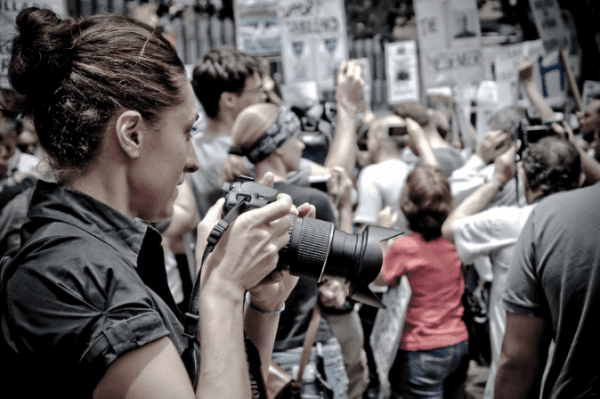
The Black Lives Matter movement erupted across the world after George Floyd, a 46 year-old black man, was pronounced dead after a Minneapolis police officer kneeled on his neck for over eight minutes (Kanno-youngs, 2020). Massive protests were accompanied by harsh law enforcement and government responses and were widely covered by the news media. With government surveillance increasing among the protests, some criticized photojournalists and news organizations for publishing photos that show the faces of individual protestors (McBride, 2020). Why? Because in some states, you can be fired for protesting and in some cases you can be charged with a crime (Spata, 2020). There is also the chance that those unsympathetic to the protest can identify individual protesters and pursue courses of public shaming. There is no U.S. law that protects your privacy in public spaces, and Frank LoMonte, the director of Florida’s Brechner Center for Freedom and Information, said “if you are marching down the street or sunbathing in the park, you waive any expectation that what you’re doing is a private activity. That is doubly so when the activity is newsworthy” (Miller & Asbury, 2020).
Ethically speaking, should journalists run photographs that show individual protester’s faces, or should they forgo such images or alter them by blurring captured faces? NPR’s public editor, Kelly McBride, spoke to these concerns, arguing that “journalists’ job is to convey reality” often captured by such photographs. Furthermore, altering the images to protect protests is worrisome, since “blurring images is a form of photo manipulation that makes them less true, and is generally an unacceptable practice for documentary photography,” (McBride, 2020). Keith Jenkins, the Senior Director of Visuals at NPR, explained that “photos and video are the most powerful tool in a storyteller’s toolkit,” and that “photos of protests are crucial for storytelling in the digital environment,” (McBride, 2020). Akili Ramsess, Executive Director of the National Press Photographers Association, commented that if people are protesting to express an idea, then “the press is out there to tell that story,” and that photographers “want the human connection” that vivid photographs can provide (Miller & Asbury, 2020). Ramses went on to say that “the whole purpose of demonstrations and civil disobedience is to put a human face on the issue and the best way to do that is to connect people to each other’s humanity” (Miller & Asbury, 2020). Danielle Kilgo, a professor at the Hubbard School of Journalism and Mass Communication at the University of Minnesota, Twin Cities, said that “the general public’s opinions about protests and the social movements behind them are formed in large part by what they read or see in the media,” (Kilgo, 2020). Without seeing detailed images of protest, and perhaps the faces of protesters, some argue that protest coverage loses important meaning (Murabayashi, 2020). Brent Lewis, Business Photo Editor at the New York Times and co-founder of Diversity Photo, explained that people who “might not deal with the issue of race and policing, might find it difficult to connect otherwise” if detailed images didn’t accompany coverage of protesters (Murabayashi, 2020). Al Tompkins, senior faculty member at Poynter, talked about journalists’ unenviable position: “on the one hand, (protesters) want us there to document the story, except when it’s not convenient. Police want us there to document the story of their compassion, of their professionalism, except when it’s not convenient, except when they’re beating somebody. You can’t have it both ways” (Miller & Asbury, 2020).
But many protesters have pointed out the dangers of having their photo being published. In Florida, you can be fired for protesting (Spata, 2020). For instance, Florida is an “at-will state,” which means that employers can fire you for a range of reasons; Cynthia Sass, an employment lawyer in Tampa, explains that “you can be fired for a good reason, for a bad reason, or no reason at all. When it comes to private employers and your First Amendment rights, they don’t apply” (Spata, 2020). In some cases, you can even be charged with a crime. In Page, Arizona, the U.S. Department of Justice alongside local police infiltrated a Facebook group that was discussing plans of rioting at the local courthouse (Swan, 2020). Four days after infiltrating the social media group, an arrest was made (Swan, 2020). The FBI also recently released a notice seeking information on individuals who incited violence at protests, citing photographs as one form of helpful information for their investigations (“Seeking Information on Individuals,” 2020). In using unedited pictures of protesting crowds, journalists may be making the government’s pursuit of those doing the protesting that much more effective. Tara Pixley, a professor of visual journalism at Loyola Marymount University and a co-founder and board member of Authority Collective said “why would we make it easier for police surveillance to identify people at protests” (Miller & Asbury, 2020)? The Society of Professional Journalists Code of Ethics, which is widely considered to be a guidebook for journalists to use, does say that journalists should “never distort the content of news photos” and that they should report the truth, but it also states that journalists should “balance the public’s need for information against potential harm or discomfort” (“SPJ Code of Ethics – Society of Professional Journalists,” 2014).
The controversy of publishing newsworthy images of protesters is a case where important journalistic guidelines are at odds with one another. What should be held over the other: photojournalistic integrity in conveying the world as it is, or the ethical consideration of those being photographed? What happens when telling newsworthy truths entails some risk or harm to those taking part in newsworthy events? How journalists navigate these conflicts will not only change how stories are written, but they might also affect some aspects of the public protests they seek to report.
Discussion Questions:
1. What values are in conflict in the case of publishing photographs of protesting crowds?
2. Should photographers/publications be barred from showing the faces of protestors in published work?
3. Would blurring the faces of individual protesters be a suitable solution to these worries? What trade-offs would accompany this solution?
4. Are there other ways that protestors can be protected in stories about acts of protest in a public setting? What drawbacks might accompany these solutions?
5. Should states enact laws that prohibit private employers from firing employees based on their protesting/demonstrating behaviors?
Further Information:
“Seeking Information on Individuals Inciting Violence During First Amendment-Protected Peaceful Demonstrations.” (2020, June 01). The Federal Bureau of Investigation. Available at: https://www.fbi.gov/news/pressrel/press-releases/seeking-information-on-individuals-inciting-violence-during-first-amendment-protected-peaceful-demonstrations
“SPJ Code of Ethics.” Society of Professional Journalists. Available at: https://www.spj.org/ethicscode.asp
Kanno-youngs, Z. (2020, June 19). “U.S. Watched George Floyd Protests in 15 Cities Using Aerial Surveillance.” The New York Times. Available at: https://www.nytimes.com/2020/06/19/us/politics/george-floyd-protests-surveillance.html
Kilgo, D. K. (2020, June 03). “How the Media Can Fix Its Protest Coverage.” Reasons to be Cheerful. Available at: https://reasonstobecheerful.world/how-the-media-can-fix-its-protest-coverage/
McBride, K. (2020, June 18). “Should Images Of Protesters Be Blurred To Protect Them From Retribution?” National Public Radio. Available at: https://www.npr.org/sections/publiceditor/2020/06/18/879223467/should-images-of-protesters-be-blurred-to-protect-them-from-retribution
Miller, E., & Asbury, N. (2020, June 04). “Photographers are being called on to stop showing protesters’ faces. Should they?” Poynter. Available at: https://www.poynter.org/ethics-trust/2020/should-journalists-show-protesters-faces/
Murabayashi, A. (2020, June 08). “No, Photojournalists Aren’t Advocating the Blurring of Faces at Protests.” PhotoShelter. Available at: https://blog.photoshelter.com/2020/06/no-photojournalists-arent-advocating-the-blurring-of-faces-at-protests/
Spata, C. (2020, June 11). “Can you be fired for protesting? In Florida, you can.” Tampa Bay Times. Available at: https://www.tampabay.com/news/2020/06/11/can-you-be-fired-for-protesting-in-florida-you-can/
Swan, B. W. (2020, June 12). “Feds comb Facebook to hunt down alleged rioters and looters.” Politico. Available at: https://www.politico.com/news/2020/06/12/facebook-riot-loot-justice-department-314567
Authors:
Claire Coburn & Scott R. Stroud, Ph.D.
Media Ethics Initiative
Center for Media Engagement
University of Texas at Austin
August 25, 2020
Image: MrReebdoog / CC BY-NC-SA 2.0
This case study is supported by funding from the John S. and James L. Knight Foundation. It can be used in unmodified PDF form for classroom or educational settings. For use in publications such as textbooks, readers, and other works, please contact the Center for Media Engagement.
Ethics Case Study © 2020 by Center for Media Engagement is licensed under CC BY-NC-SA 4.0



